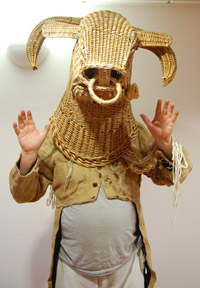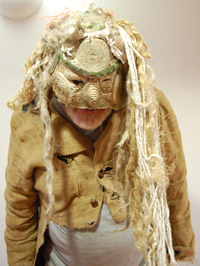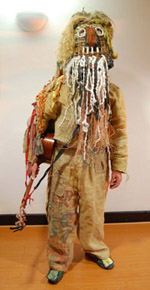
Armagh Rhymers revive an Irish tradition while building community
 The traditional bull mask.
The traditional bull mask.
Two figures play a slow melody as they enter a room, their faces hidden by masks made of flax, willow and straw. One man is wearing a mask shaped like the head of a bull. The other sways to and forth in a mask with white menacing eyes, an orange nose and black-and-white strings hanging down from his gangly teeth.
The man in the bull’s head takes gallant strides toward the center of the room in front of a small gathering of students. He sings with an Irish brogue that makes some of his words hard to catch. The other man grabs a bodhran, a traditional Irish drum, which is strapped around his shoulder. As he sings about the old legends of Ireland, the man wearing the mask with the head of a bull plays a concertina, a musical instrument that resembles an accordion. The men also bang on plastic buckets and ring bells as part of their performance.
After an hour of song, music and dance at the Armagh City Youth Hostel, the two men introduce themselves as Dara Vallely and Peter Shortall, two of the founders of the Armagh Rhymers [http://www.armaghrhymers.com], a local group that strives to preserve Irish tradition through the ancient tradition of mumming: singing, dancing and playing music while wearing a mask or disguise. “The masked tradition of 'mumming' in Ulster dates back 2500 years. In the ancient annals of Ulster, men in tall conical masks are mentioned as chief entertainers to King Conor, who lived at the royal fort of Emain Macha,” according to the Armagh rhymers website.
As mummers, also known as rhymers, strawboys, wrenboys, biddymen, Halloween pranxters and Mayboys, Vallely and Shortall perform the Mummers’ play, which can have as many as 20 different characters. These plays are performed during Christmas time and were known as an integral part of the festivities in Ulster. Though the tradition is not as common among the youth, Vallely and Shortall are part of a small but devoted group of mummers who are doing everything they can to keep the tradition alive.
“It is incredible that this here custom has survived against a tall tide of affluent decadent culture,” says John Nixon, owner of an art gallery in Armagh, who sometimes performs with Vallely and Shortall. “All these ancient traditions are not yet gone or dead, in fact in many ways, they are epitomized in the performance and the existence of the mummers.”
The Armagh Rhymers have been performing house to house for 30 years performing the legends of old Ireland. The group has been all over the world, including: Milwaukee, Wisconsin, New Orleans, Ohio as well as Hungary, Austria, and Germany. They are among a dozen well-known groups that take part in the tradition of mumming. The Philadelphia Mummers perform a special parade that features costumes, music, and pageantry and is held on New Year’s Day. Another group of mummers found in Scotland are known as “guisers”(for disguise).
The group performs at special celebrations throughout Ireland and in different cultures all over the world. At any one time, there are 50 to 60 rhymers from the town of Armagh and neighboring towns such as Monaghan, all performing together. Most of the rhymers can be seen on Celtic holidays such as Saint Stephens Day, also known as the “hunting of the wren.” Saint Stephens Day is held the day after Christmas and celebrates the wren as “the king of the birds.” But the Armagh Rhymers will perform at almost any occasion, upon request.
“A girl has us booked for her wedding in 2010,” Shortall says with a chuckle. The girl saw the rhymers when she was a young girl in school. Beginning in August the rhymers will begin touring the schools again.
One aim of the rhymers, founded by Vallely, Shortall and Brendan Bailey, who died last year, is to bring children together through theater and the art of mumming. “Without Dara and myself getting together and god rest his soul Brendan Bailey and bringing this play into the schools and bringing mumming and rhyming into the schools it would have been a lost tradition,” Shortall says.
 The traditional mask of Crom Dubh.
The traditional mask of Crom Dubh.The Armagh Rhymers spend a great deal of their time touring schools in Ireland. Each year, they perform at about 300 different schools hitting about 60,000 kids a year. The mummers engage the students by bringing them up on stage and having them perform with them.
“We would impress on the children that our stage is the kitchen floor,” Vallely said, recalling his often-used speech children who might not understand the importance of mumming in Irish tradition. “Everything starts on the kitchen floor. That’s where you learn to walk and talk and sing your first song climb, your first mountain, or produce your first painting.”
The group also makes a point of touring both Catholic and Protestant schools to promote cross-community understanding and foster a sense of peace. "We have been pioneers in a multi-cultural approach to solving conflict in the community, bringing together Catholic and Protestant children in Ireland and in the United States, Jewish, Irish, Episcopalian, black, white, and Spanish together," a quote from Dara Vallely’s website reads.
One of the legends the group performs has to do with the deep divide that once existed between Christianity and Paganism. In what is known as the “debate of the ancient ones,”
Oisín, asks St. Patrick:
“Where are all my warriors?”
“They’re in hell,” St. Patrick tells Oisin. “I baptize you now and you can come to heaven with me.”
“I would prefer to dance barefoot on the flagstones of hell,” Oisín shouts back.
For Vallely, who recounted this epic tale, this exchange embodies the intensity of language and devotion to faith that St. Patrick, an advocate for Christianity, and Oisín, a devout Pagan.
For more information about the Armagh Rhymers, including when and where they will perform as well as the various plays they perform including the Navan Dragon, the Enormous Turnip and the Giant’s Garden go to http://www.armaghrhymers.com/
For information about Dara Vallely, the rhymers and the history of mumming go to http://www.daravallely.com/mumming.htm
